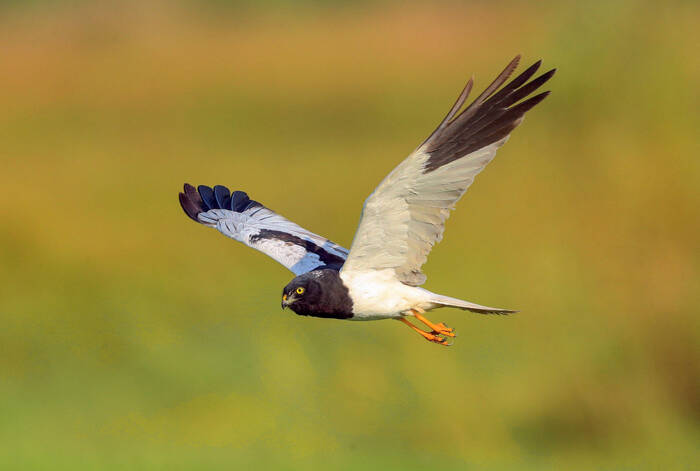Circus melanoleucos
IUCN
LCBasic Information
Scientific classification
- name:Circus melanoleucos
- Scientific Name:Circus melanoleucos,Pied Harrier,Magpie hawk, magpie hawk, black-and-white hawk, buzzard
- Outline:Raptor
- Family:Falconiformes Accipitridae H.subfamily H.genus
Vital signs
- length:42-48cm
- Weight:250-380g
- lifetime:8-16years
Feature
It is named because it looks like a magpie when standing.
Distribution and Habitat
Origin: Bangladesh, Bhutan, Cambodia, Mainland China, Hong Kong, India, Indonesia, Democratic People's Republic of Korea, Republic of Korea, Lao People's Democratic Republic, Malaysia, Mongolia, Myanmar, Nepal, Pakistan, Philippines, Russian Federation (East Asia), Singapore, Sri Lanka, Thailand and Vietnam.
Wandering: Brunei Darussalam and Japan.
In China, it is distributed in Guangdong, Macao Special Administrative Region, Shaanxi, Henan, Jiangxi, Shanghai, Jilin, Anhui, Tianjin, Hebei, Chongqing, Gansu, Shanxi, Jiangsu, Sichuan, Fujian, Hunan, Zhejiang, Guizhou, Taiwan, Liaoning, Shandong, Beijing, Inner Mongolia Autonomous Region, Hong Kong Special Administrative Region, Guangxi Zhuang Autonomous Region, Hubei, Heilongjiang and Yunnan.
It lives and moves in open low mountains and hills, plains at the foot of mountains, grasslands, wilderness, river valleys, swamps, forest edges and roadside shrubs and swamp grasslands in the forest. After the breeding season, it
Appearance
The male magpie harrier has black head, neck, back, shoulders, 6 primary flight feathers and middle coverts on the outside, silver-gray primary flight feathers, secondary flight feathers and large coverts on the inside, white inner feather edges, white small coverts on the wings; white waist and upper tail coverts with silver-gray luster, gray-brown spots on the upper tail coverts, silver-gray tail feathers with brown, except for the central pair of tail feathers, the outer tail feathers have gray-white tips and inner feather edges. The lower body chin, throat to upper chest are all black as one with the head, neck and back, and the lower chest, abdomen, flanks, leg coverts and lower tail coverts, wing coverts and armpits are all pure white.
The female has dark brown upper body, brown-white feather edges on the head, narrow brown feather edges on the back and shoulders; the tail feathers are gray-brown with black-brown horizontal stripes; the outer flight feathers of the wings are d
Details
Pied Harrier is a medium-sized bird of prey with no subspecies.

Pied Harrier is a summer migratory bird in Northeast China and a winter migratory bird and traveling bird in other areas. The time of migration to the breeding grounds in northeast China is from early April to mid-April, and the time of leaving the breeding grounds is from late October to early November.
Magpie kites often move alone, mostly flying low over the grass and bushes near the forest. When flying, they raise their wings in a "V" shape, keep their wings still, and slowly float in the air, moving up and down and forward from time to time, shaking their wings and bodies from time to time or briefly flapping their wings. The peak of activity is in the morning and dusk, and they rest in the grass at night. The call is not loud at ordinary times, and only in the breeding season will they make a loud and sharp call, like "ki-ki-".
Magpie kites mainly feed on small animals such as birds, mice, forest frogs, lizards, snakes, insects, etc. They often hunt on the bushes and grasslands at the edge of the forest and in the sparse forests. They mainly forage by flying at low altitude or floating on the grassland for a long time, moving slowly, watching and searching for prey on the ground, and suddenly descending to hunt after finding it.
The breeding season of the magpie harrier is from May to July. After entering the breeding ground, they often fly in pairs over the sparse forests and bushes and meadows at the edge of the forest and the roadside between the forests for courtship. The male bird circles in the air, then dives from time to time and runs towards the female bird, and mating takes place on the ground. They start to build nests in early May. The nests are mostly placed on the tower grass mounds or on the ground in the shrub meadows in the sparse forests. The nest is shallow and is made of grass stems and leaves of dry moss. The outer diameter of the nest is 40-71 cm, the inner diameter is 17-40 cm, and the depth is 4.8-5 cm. If there is no interference, the nest can be used for many years. Each nest lays 4-5 eggs, which are milky white or light green, usually without spots, occasionally with brown spots, and oval in shape. The size is 41-47 mm × 32-36 mm. After the first egg is laid, the incubation begins, and the male and female parents take turns to incubate the eggs, but the female is the main one. If the female dies, the male will take on the task of incubating the eggs. The incubation period is about 30 days, and the chicks are late-maturing. The parents raise them together for about a month before they can leave the nest.
There are an estimated 10,000-100,000 breeding pairs and 1,000-10,000 migratory individuals in China. The global population of magpie harriers is estimated to be greater than 10,000, and the population is on a downward trend. The magpie harrier has a wide distribution range and is not close to the critical value of vulnerable and endangered species survival (distribution area or fluctuation range is less than 20,000 square kilometers, habitat quality, population size, and fragmented distribution area). The population trend is stable, so it is evaluated as a species with no survival crisis.
Listed in the "Red List of Endangered Species of the World Conservation Union" (IUCN) 2016 ver 3.1-Least Concern (LC).
Listed in the "Washington Convention" CITES Appendix II protected animals.
Listed in the second level of China's "National Key Protected Wildlife List" (February 5, 2021).
Protect wild animals and stop eating game.
Maintaining ecological balance is everyone's responsibility!








